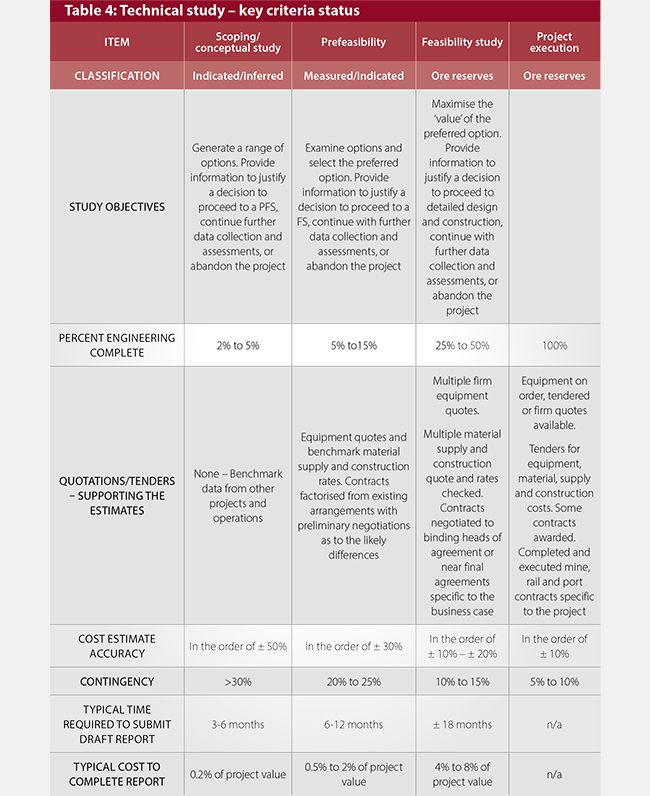The following section includes a broad summary of the typical types of technical studies completed in respect of mineral assets as they progress through each development stage. Technical information expected in respect of exploration properties is discussed separately and these are generally focused on the development of exploration programmes comprising: activities; schedules; and associated expenditures, which are deemed warranted given the available geological information.
Technical studies
The development of international technical study standards has to some degree lagged the more formal and structured processes established for development of mineral resource and ore reserve reporting standards.
Nevertheless, common usage has established common terminology where progression from conceptual/scoping, through pre-feasibility study (PFS) to feasibility study (FS) largely parallels the development stage as the extent and influence of site specific information and level of engineering increases. Furthermore, and largely owing to an apparently broad spectrum for feasibility studies and the need for differentiation for project finance considerations, recent developments introduced the concepts of definitive feasibility studies (DFS) and/or bankable feasibility studies (BFS).
During the recent commodity price boom further developments included: the direct progression to single option feasibility studies and omitting the PFS stage; or advancing directly to front-end engineering design (FEED) as a precursor/parallel to engineering, procurement and construction management (EPCM).
The principal technical disciplines to be addressed in the development of mineral assets, albeit to appropriate and different levels at each development stage, comprise that noted in Table 3.
The range of technical studies can be largely grouped in accordance with the following key criteria:
- Classification of Mineral Resources
- The overall study objectives
- The availability of, and reliance on, site-specific technical information
- The degree of engineering completed, measured by reference to percent complete
- Design basis and cost estimation methodology
- Cost estimation accuracy for both capital and operating expenditures
- The level of contingency deemed applicable.
Table 4 presents a detailed summary of the range of technical studies completed and the expected level of detail to support such studies.


Exploration properties
The advancement of exploration properties is largely affected through the development of well-defined exploration programmes comprising scheduled activities, associated expenditures and targeted milestones. The overall process can be readily subdivided into the following three key areas, which, for grassroots exploration, culminate in the delineation of mineral resources.
- Regional scale area selection: This is largely focused on geologically prospective areas in a mineral field, geological region or terrain. Specifically, this combines ore genesis theories pertaining to known ore type occurrences and geological maps to make predictions and draw parallels between the physical forms of such occurrences and the unknown potential of identifying a ‘look-alike' area of interest within the area selected. This process may also be supplemented by remote sensing data (aerial photography; satellite imagery) processing and analysis
- Target selection (mineral licence scale): Following the identification of areas of interest, this typically involves geological investigations via site specific intrusive investigations including: geological mapping; large scale geophysics (airborne; satellite imagery) and geochemical investigations and/or intensive geophysical testing of the surface and sub-surface geology. In certain instances, specifically where the surface comprises soil, alluvium and platform cover, exploration drilling may be performed directly as a mechanism for generating targets
- Definition drilling: On identification of specific local scale targets identified within exploration licences, exploration activities extend to trenching and/or drilling to test outcrops and/or structural lineaments. The ultimate aim is to test and hopefully delineate an exploration target (JORC, 2012) with a quantifiable range of tonnage and grade/quality of a mineral occurrence. Typically, this is achieved by execution of a detailed drilling programme comprising a designed drilling grid, geological logging, sample collation and laboratory testing supplemented by appropriate quality assurance and quality control.
Typically, exploration programmes are inexorably linked to specific legally binding commitments associated with the award of exploration licences. Furthermore, it is generally accepted that unless results dictate otherwise, some degree of areal relinquishment is expected on an agreed milestone/ timeline basis.
Accordingly, development of a detailed and well-managed exploration programme is key to the management of stakeholder (investor, governmental, community) expectations.

Image: Anglo American
A Life-of-mine plan (LoMp), the scope of which is multi-disciplinary in nature, the foundations of which comprise: the annual mineral resource and ore reserve statements; mine to mill to saleable product production schedules; annual operating budgets; activity and element based operating expenditures; detailed on-going and project capital expenditure requirements; an integrated financial model to establish as a minimum post-tax pre-finance schedules. In addition it is expected that the base case encompasses depletion of the ore reserves as well as all necessary considerations for additional infrastructure requirements, inter alia: waste deposition (mine waste and process plant residue); water management (dewatering/water treatment); off-mine infrastructure (transport corridors and port facilities); and mine closure considerations.
Commissioning and turnover to operations: Vendor representatives and field engineering personnel take part in the formal completion of the project including proof of operability testing and acceptance by the owner that the project construction and performance is as per the design and that it meets the required plant performance and safety requirements. In parallel, the final operating control programmes are completed, installed, and tested. All final project information including final design packages, as-built drawings, contract packages and contract close-out documents, operations and maintenance manuals for equipment, quality assurance/quality control records, commissioning records etc are assembled and formally turned over to the owner.
Site construction: During the course of construction, ‘home office' and field engineering will address construction change and drawing/specification clarification issues that arise during the course of construction, carry out inspections to confirm that construction is as per the design, and confirm adherence to appropriate quality control practices. Site engineers may also be required to confirm appropriate as-built records are kept, assemble records of vendor documents (installation instructions, operating manuals, maintenance manuals), and other construction control activities.
Detailed engineering: This stage includes completion of detailed designs based on the project scope and concept designs approved in the FS, and the issuing of ‘for construction' designs, provision of construction and equipment specifications, scope of work packages for contract documents, definition of and procedures for construction quality control, etc. The purchase of key plant equipment often occurs prior to or in parallel with this stage of design, as vendor drawings for equipment are required in order to complete the detailed engineering designs.
A comprehensive study of a mineral deposit in which all geological, engineering, legal, operating, economic, social, environmental and other relevant factors are considered in sufficient detail so that it could reasonably serve as the basis for a final decision by a financial institution to finance the development of the deposit for mineral production. For the avoidance of doubt, this would commonly ensure that the technical feasibility and economic viability of the mineral deposit has been demonstrated on a multi-disciplinary basis to what is commonly known as ‘bankable standards'. In a FS, the declaration of ore reserves would be expected and the economic viability of the mineral deposit could be demonstrated with sole reliance on the depletion of the ore reserves without inclusion of mineral resources. In parallel to the development of the FS, it is normally expected that an Environmental and Social Impact Study Assessment would have been completed and the processes for obtaining the primary approvals for the development are well advanced. Typical contingencies included within the capital expenditure estimate range between 10% and 15% and accuracy ranges are typically ± 15%.
A comprehensive study of the viability of a mineral project that has advanced to a stage where the mining method, in the case of underground mining, or the pit configuration, in the case of an open pit, has been established and an effective method of mineral processing has been determined, and includes a financial analysis based on reasonable assumptions of technical, engineering, legal, operating, economic, social, and environmental factors and the evaluation of other relevant factors which are sufficient for a qualified person, acting reasonably, to determine if all or part of the Mineral Resource may be classified as an Ore Reserve. For the avoidance of doubt this would commonly ensure that the technical feasibility and economic viability of the mineral project has been demonstrated on a multi-disciplinary basis to PFS levels and accordingly the declaration of Ore Reserves would be expected. SRK notes that such studies are not normally dependent on Inferred Mineral Resources to demonstrate economic viability and generally include appropriate contingencies (± 20% to 25%) with respect to capital expenditures to account for the lower amount of site specific engineering designs completed compared to that normally included in a FS. Furthermore it is also general industry practice to acknowledge that such studies in reflecting a lower degree of accuracy are accompanied by higher accuracy/ sensitivity ranges (± 20%). Key deliverables of a PFS would include a recommendation of a single and sufficiently positive technical and economic outcome such that advancement to FS level is warranted.
Scoping study
A study that includes an economic analysis of the potential viability of mineral resources taken at an early stage of the project prior to the completion of a PFS. A scoping study may be based on measured, indicated, or inferred mineral resources or a combination of any of these and include disclosure of forecast mine production rates and may contain capital costs to develop and sustain the mining operation, operating costs. For the avoidance of doubt a scoping study would seek to establish the mining method and process route to establish the nature and scale of the mineral project. A scoping study would have limited site specific data in respect of key operating assumptions and would only address certain disciplines on a high level fatal flaw basis. Both the contingency (>30%) and accuracy/sensitivity (± 30%) associated with key assumptions are generally higher than that assumed for the PFS. Key deliverables of a scoping study would include the determination of sufficiently positive technical and economic outcomes such that advancement to PFS level is warranted. A scoping study is preliminary in nature, in that it generally includes inferred mineral resources that are considered too speculative geologically to have the economic considerations applied to them that would enable them to be categorised as ore reserves, and there is no certainty that the technical and economic aspects presented will be realised.
A study that incorporates inherently lower level of accuracy and confidence with respect to technical and economic parameters normally included in a scoping study. A conceptual study may only include inferred mineral resources and/or further assumptions regarding exploration targets. Accordingly site specific data may be limited and reliance on generic assumptions derived from comparable situations is common.

Image: Anglo American
Explore the full Mining Journal Intelligence Global Finance Report 2022
Technical Glossary
MINING JOURNAL GLOBAL FINANCE REPORT 2022
Technical Glossary: Technical study standards
This chapter is authored by leading global mining expert, SRK Consulting
MINING JOURNAL GLOBAL FINANCE REPORT 2022
Technical Glossary: Mineral asset valuation standards
This chapter is authored by leading global mining expert, SRK Consulting
MINING JOURNAL GLOBAL FINANCE REPORT 2022
Technical Glossary: Permitting and Sustainability
This chapter is authored by leading global mining expert, SRK Consulting
MINING JOURNAL GLOBAL FINANCE REPORT 2022
Technical Glossary: Funding options: technical expectations
This chapter is authored by leading global mining expert, SRK Consulting
MINING JOURNAL GLOBAL FINANCE REPORT 2022
Technical Glossary: Mineral Resources and Ore Reserve reporting standards
This chapter is authored by leading global mining expert, SRK Consulting


























